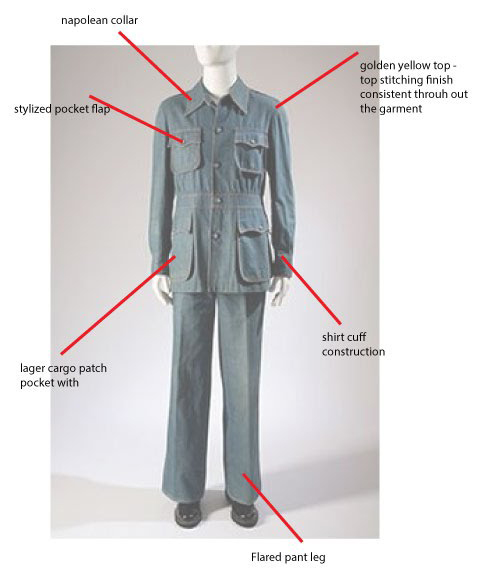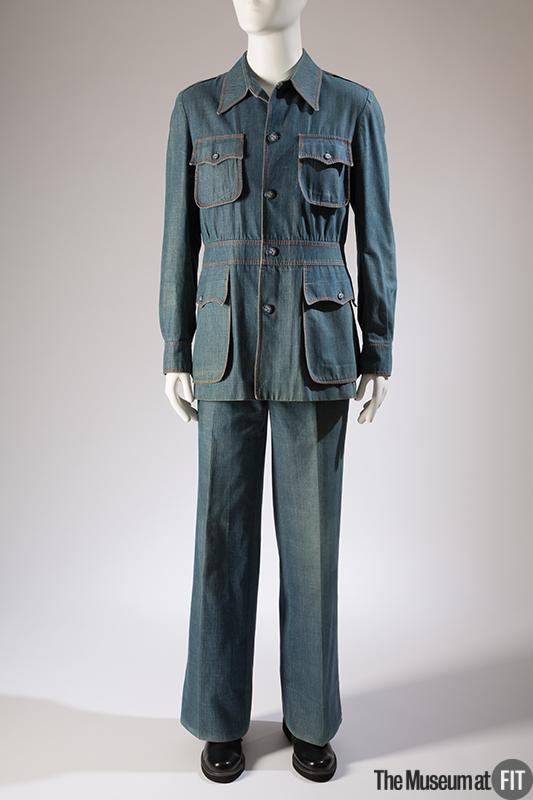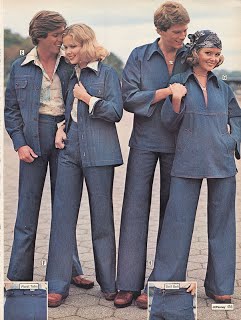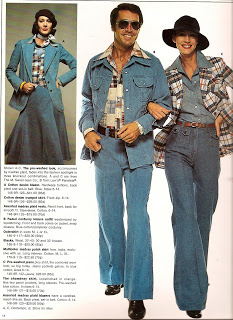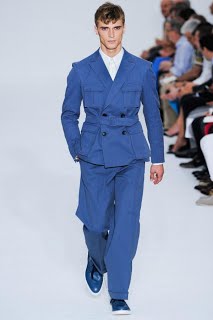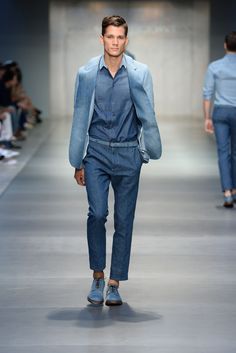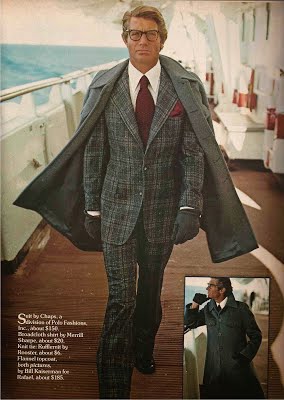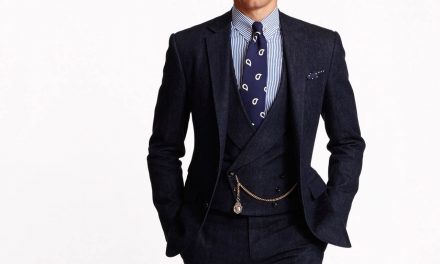Bill Kaiserman (Rafael) was a retail salesman turned hat maker who influenced that fashion world by introducing the leisure aesthetic to the American fashion market in the early 1970s.
About the Look
This look was created in 1973. It is a blue wash denim leisure suit that consists of a matching jacket and pant. The front of the jacket is adorned with four round flap cargo pockets. It is finished with traditional denim top stitching complete with a self placket belt panel. Produced in Italy, Bill Kaiserman’s clothes became the standard in the American fashion market. The public welcomed the look as it was on trend at the time.
Rafael (Bill Kaiserman) (American, born 1942). Man’s Suit, circa 1973. New York: The Museum at FIT, 85.161.8. Gift of Chip Tolbert. Source: The Museum at FIT
About the Context
Informal suits in unconventional materials began to appear on the west coast of the US in the late 1930s as summer casual-wear for the wealthy. But, as Webster’s Dictionary notes, the term “leisure suit” was only first used in 1975, when it was defined as “a suit consisting of a shirt jacket and matching trousers for informal wear.” Tyler Beard and Jim Arndt speculate as to the leisure suit’s origin in 100 Years of Western Wear (1993):
“possibly derived from the heavy tweed Norfolk jacket or khaki safari jacket worn by English sportsmen. Made from lightweight fabric and originally known as ‘Hollywood suits’ these were worn until the 1950s, especially in the Southwest where, together with suits derived from the Ike jacket they became popular formal-wear and often featured contrasting yokes, collars and cuffs.” (72)
“Denim: Fashion’s Frontier” curator Emma McClendon describes the 70s context on the Museum at FIT’s “Denim: Fashion’s Frontier” website:
“During the 1970s, denim made its debut as a suiting material. At the same time, the “leisure suit” was a fixture of the fashionable man’s wardrobe. Leisure suits were characterized by their relaxed, elongated jackets, and were paired with flared pants. The all-denim leisure suit seen here is a clear homage to Yves Saint Laurent’s unisex safari suits and jackets.”
In addition to Rafael’s millinery line and leather goods, he began pair cashmere sweaters and silk shirts together with the safari suit. With that combination he developed a revolutionary new shape in menswear establishing the concept of the leisure suit and leisure dressing for men.
Its Afterlife
This denim leisure suit was featured in the Museum at FIT’s 2015-16 exhibition, “Denim: Fashion’s Frontier,” but the legacy of 70s leisure suits is even visible in the work of designers today. For example, a Spring/Summer 2012 Zegna look (Fig. 3) is very clean, on trend with an updated leisure feel. With its monochromatic color story this look is a great update to the Bill Kaiserman for Rafael’s leisure suit with a self-belt that evokes the Norfolk jacket. These days with ‘neo-retroism’ as a constant theme, we begin to see the sixties and seventies revived on the runway, especially when denim is being used. Menswear is always at a crossroads between traditional clothing and comfortable, casual and appropriate dress. Ermanno Scervino’s Spring/Summer 2014 collection (Fig. 4) included a much-needed update to the traditional 70s look, slimming down and editing the leisure suit. Instead unnecessary bulky pockets and top-stitching, the focus seems to be more towards the denim color and fabric finishing/treatment. The denim suit is appropriated and tailored as a traditional wool suit, leaving behind the physical leisure details and reclaiming a more relaxed and relevant aesthetic.
Fig. 3 - Zegna (Italian). Milan Fashion Week, Spring/Summer 2012. Source: Vincent Ko
Fig. 4 - Ermanno Scervino (Italian). Menswear, Spring/Summer 2014. Source: Uomo Moderno
About the Designer
The American, Milan-based, designer founded the Rafael line in 1970, attaining widespread success (Fig. 5). As Kevin Almond and Lisa Groshong note in their biography of Kaiserman:
“Amply recognized for his contribution to American fashion, Kaiserman has received several Coty awards and a Hall of Fame citation for his contribution to menswear…. It is ultimately his menswear concept that was Kaiserman’s greatest contribution to fashion. His leisurewear opened up greater boundaries for menswear design as a whole, and his leisure suit became a liberated classic for many men. He chose the name Rafael because he thought it would look better in print than his own; ironically, his name as a designer eclipsed the label he chose to represent his product. In the 1980s, Kaiserman disappeared from the fashion industry, closing Rafael and moving to Italy.” (357)
His womenswear line and later revival of a menswear line backed by Kashiyama & Company, a licensee of menswear from Ralph Lauren and Calvin Klein, would not prove as successful as his 70s leisure looks.
Fig. 5 - Bill Kaiserman for Rafael (American, 1942-). Flannel topcoats featured in GQ, Winter 1973. Source: Pinterest
References:
- Almond, Kevin, and Lisa Groshong. “Kaiserman, Bill.” Contemporary Fashion. Edited by Taryn Benbow-Pfalzgraf. 2nd ed. Detroit: St. James Press, 2002.
- Beard, Tyler, and Jim Arndt. 100 Years of Western Wear. 1st ed. Salt Lake City: Gibbs-Smith Publisher, 1993.
- “Bill Kaiserman.” Wikipedia, December 31, 2016. https://en.wikipedia.org/w/index.php?title=Bill_Kaiserman&oldid=757502060.
- “Definition of LEISURE SUIT.” Accessed January 8, 2018. https://www.merriam-webster.com/dictionary/leisure+suit.
- “Denim: Fashion’s Frontier | Fashion Institute of Technology.” Accessed January 8, 2018. http://www.fitnyc.edu/museum/exhibitions/denim.php.
- “Kaiserman licenses Hartz & Co. (clothing designer Bill Kaiserman) (Brief Article).” Daily News Record. 1992. HighBeam Research. (January 8, 2018). https://www.highbeam.com/doc/1G1-12268191.html
-
“Leisure Suit.” Wikipedia, December 20, 2017. https://en.wikipedia.org/w/index.php?title=Leisure_suit&oldid=816281681.


